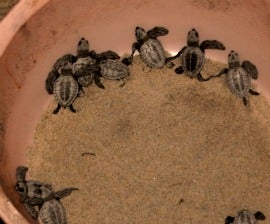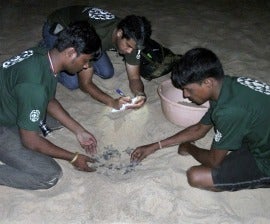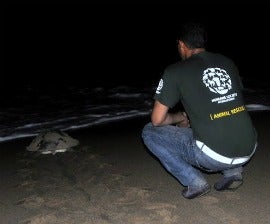-

Olive ridley sea turtle hatchlings rescued by volunteers. HSI
-

Volunteers assist hatchlings with digging to the surface. HSI
-

A nesting female heads back to sea after laying eggs. HSI
Located on the eastern coast of India, the state of Orissa is known to host the world’s largest olive ridley sea turtle nesting site. Every year, between the months of December and April, thousands of olive ridleys emerge from the cool, clear waters of the Bay of Bengal for their famed mass nesting, also known as arribada, derived from the Spanish word for arrival.
In India, the rapid pace of development has had serious environmental consequences. Orissa is no exception. Development along and close to the shore of the Bay of Bengal includes several ports, shipbuilding yards, petro-chemical manufacturing hubs and a Special Investment Region (SIR) meant to spur urbanization.
Conservation status
Not surprisingly, data released by the state’s forest and wildlife department reveals a sharp decline in the number of olive ridley turtles in the last decade. In recent times, some historical arribada sites have only recorded intermittent nesting. Shockingly, beach erosion caused some turtles to nest in a fishing village this year—despite all the human activity! Global numbers have declined to a point where the olive ridley turtle is now classified as Vulnerable by the IUCN.
Happily, direct intervention by our team in India has already helped save the lives of several hundred olive ridley hatchlings this year, and the community teams trained by our wildlife experts could go on to save thousands.
“Close to 75 percent of the turtles’ nests throughout the coasts have been submerged in water due to high tides this year,” said HSI’s Soham Mukherjee. While mass nesting sites received a great deal of attention from conservationists, irregularly used sites were almost entirely ignored.
Working together to help
HSI partnered with a local NGO, Action for Protection of Wild Animals (APOWA), which has been working on olive ridley conservation in the region for several years. Along with members from the local fishing community, we surveyed the stretch of the Pir Jahania beach. The first few days of our survey revealed the various threats faced by the ridley nests. Several had been dug up and feasted upon by feral dogs and pigs. Another obstacle to the survival of the hatchlings was the unseasonal rain that made the sand wet and heavy. By the time the hatchlings had dug their way out of the nests, our team found them exhausted and unable to reach the sea without assistance.
While in other parts of the world, impoverished local communities often poach eggs or trap turtles for their skin, Hindu mythology gives the turtle divine status. Fishermen in the region steer clear of causing deliberate harm to the olive ridley. This offers conservation teams a fantastic opportunity to tap into local communities for volunteers and assistance.
Learning what to do
Three local beaches have been identified as sporadic nesting sites. A team of volunteers trained by our experts will patrol them to protect olive ridley nests from feral dogs. They will continue to assist hatchlings into the ocean and educate other community members and tourists.
“They were amazing. Very, very receptive and eager to learn,” said Mukherjee, who is an expert in humane handling, about the local fishermen who had been recruited to help with conservation. Fishing is officially banned during the nesting season and engaging the public during this period is a sustainable, long-term solution. The men were very eager to help, some even having attempted rescue efforts on their own in the past.
For the first time, the volunteers were trained in proper handling of olive ridley turtles. “Various subtle nuances of conservation efforts, like releasing the hatchling immediately into the ocean to avoid unnecessary handling and ensuring that the volunteer’s flashlight does not unintentionally disorient the turtles, were taught through practical sessions on the beach,” Mukherjee explained. Our team supervised several rescue efforts by the volunteers during and after the formal training sessions.
“It was a moonless night and when you switched off your flashlight, all you could see was an abyss of darkness… and then there was a lone female emerging to lay her eggs. Meanwhile, just a few meters away, a pack of 10 dogs stood waiting. Thankfully, all 105 eggs that that gorgeous female laid that night were rescued,” said Rahul Sehgal, director of HSI/India.
Project timeline
HSI and APOWA’s olive ridley sea turtle conservation project will continue over the next few weeks. Our hope is to have safeguarded at least 5,000 hatchlings by the end of the month.
